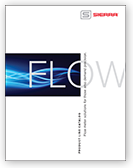Official Blog of Sierra--Let's Talk Flow!
Part 1: Capillary Thermal Flow Meters vs. Differential Pressure Devices
The most common technology in use today for measuring flow is differential pressure “dP or ΔP” (orifice plates, pitot tubes, venturis and the like). Indeed, that was the only flow measurement method I was taught in engineering school. Well, things have come a long way in the 28 years since I picked up my degree. Today coriolis, ultrasonic, vortex, thermal and magnetic flow meters have all found their niches, although dP meters are still the most common due to the large installed base.
Sierra’s premium mass flow controllers in our 100 Series operate on a particular type of thermal, called capillary thermal. I’d like to examine how capillary thermal stacks up against a typical differential pressure meter. Take the ubiquitous orifice plate, for example. It measures volumetric flow rate using Bernoulli’s principle, which states that there is a relationship between the pressure of the fluid and the velocity of the fluid. When the velocity increases, the pressure decreases and vice versa. By forcing the fluid through a small hole (the “orifice”) and measuring the pressure drop across the plate (ΔP), the volumetric flow rate Q can be found, specifically Q ∝ √ΔP.
There is one major disadvantage with ΔP devices, however. All ΔP devices measure volumetric flow. In most processes, mass flow is the parameter of interest. This means the density (ρ) of the fluid must be known. Density (ρ) is dependent upon temperature (T) and pressure (P). So in order to obtain mass flow from a ΔP device, I must measure P1, P2 in order to get ΔP. Then, I must measure T and P in order to derive ρ and, finally, use a flow computer to calculate the mass flow M = Q ρ. Of course, each transducer contributes to the complexity, error and expense of the measurement.
So, how does capillary thermal simplify this process? Stay tuned for part 2 of capillary thermal flow meters vs. differential pressure devices.
Scott Rouse, Product Line Director
Sierra Instruments

 Go to Autotest Division >
Go to Autotest Division > DOWNLOAD
DOWNLOAD